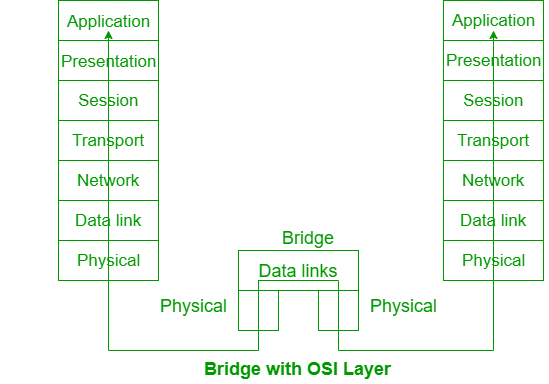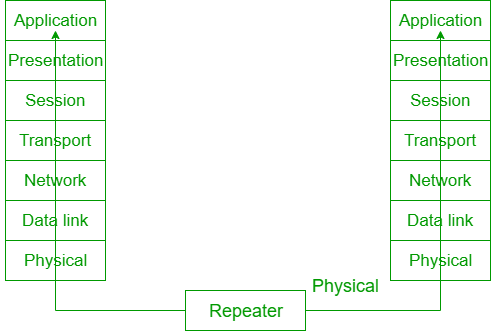Difference between Bridge and Repeater
Last Updated :
06 Jun, 2022
Prerequisite – Network Devices Bridge: Bridge operates at the second layer i.e. data link layer of the ISO-OSI model. It connects the two networks together that uses the same protocol. Bridges are relatively easy to configure and focuses on MAC addresses. 
Repeater: Repeater is an electronic device. It is a hardware device used to extend a local area network. Repeater operates only on the physical layer i.e. first layer of the OSI model. It regenerates the weak signal and increases the range of the network. Functionality of the network remains unchanged by the use of repeater. Switch can be used as a repeater but hub cannot be used as a repeater.  Let’s see the difference between Bridge and Repeater:
Let’s see the difference between Bridge and Repeater:
| S.No. |
Bridge |
Repeater |
|
| 1. |
Bridge operates at the data link layer of OSI Model. |
Repeater operates at the physical layer of OSI Model. |
|
| 2. |
The complete frames is understand by bridge. |
Repeater do not understand complete frames. |
|
| 3. |
Destination address is used in the bridge to determine in case to forward a frame. |
Repeater are not able to recognize the destination address. |
|
| 4. |
In the network, if collision occurs in the one segment is not forwarded to another segment by bridge. |
Repeater forward the collision from one segment to another, which causes the same issue to be occurred on all other segment in the network. |
|
| 5. |
Bridge connects two network in a well organized manner. |
Repeater expands the limit of the signals in the network. |
|
| 6. |
Filtering of the packets in network is achieved by the bridge. |
Repeater cannot performs packet filtering. |
|
| 7. |
Bridges are relatively expensive and used to extend a LAN. |
Repeater is also used to extend a LAN, but comparably economical than the bridge. |
|
Like Article
Suggest improvement
Share your thoughts in the comments
Please Login to comment...